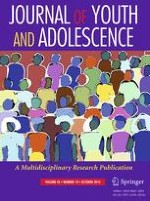26-05-2016 | Empirical Research
Caregiver and Adolescent Discrepancies in Perceptions of Violence and Their Associations with Early Adolescent Aggression
Gepubliceerd in: Journal of Youth and Adolescence | Uitgave 10/2016
Log in om toegang te krijgenAbstract
This article examined the role of caregiver messages about violence and exposure to neighborhood violence on adolescent aggression in light of research regarding discrepancies between parents and their children. Drawing upon data from an urban African American sample of 144 caregiver/early adolescent dyads (M = 12.99; SD = 0.93; 58.7 % female) we examined covariates of discrepancies between caregiver and adolescent reports of perceptions of violence as well as their association with adolescent aggression. Analyses suggested that concordance in perceptions of violence was associated with children’s attitudes about violence and caregivers’ perceptions of family communication. Structural equation modeling indicated a unique role for individual perceptions and suggested that agreement in awareness of neighborhood violence could be protective for early adolescent involvement in aggression.
